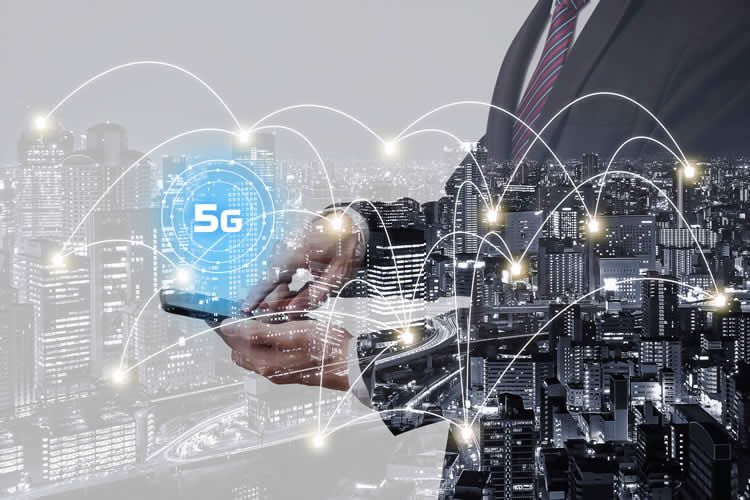
Enhanced Mobile Broadband (eMBB) is one of three sets of use cases defined for 5G. As an extension to existing 4G broadband services, they will be the first commercial 5G services to launch but they will go far beyond just enabling faster download speeds. Read on to find out what eMBB is and what it will allow us to do.
What is eMBB?
Enhanced Mobile Broadband (eMBB) is one of three primary 5G New Radio (NR) use cases defined by the 3GPP as part of its SMARTER (Study on New Services and Markets Technology Enablers) project.
The objective behind SMARTER was to develop high level use cases and identify what features and functionality 5G would need to deliver to enable them. It began in 2015 and resulted in over 70 use cases, initially grouped into five categories which has since been trimmed to three. They are characterised by the performance attributes the particular use cases will require, although there is some overlap. The three sets of use cases are as follows:
- Enhanced Mobile Broadband (eMBB): data-driven use cases requiring high data rates across a wide coverage area.
- Ultra Reliable Low Latency Communications (URLLC): strict requirements on latency and reliability for mission critical communications, such as remote surgery, autonomous vehicles or the Tactile Internet.
- Massive Machine Type Communications (mMTC): need to support a very large number of devices in a small area, which may only send data sporadically, such as Internet of Things (IoT) use cases.
Below we explain in detail what eMBB will enable, but many, many things will rely on it, from AR and VR to real-time translation and generally just making the mobile internet experience faster and more seamless.
It’s the aspect of 5G that’s arguably the most obvious evolution of what 4G does – enabling newer and better versions of experiences that we can already have, as well as some completely new stuff.
Further reading:
When is it coming?
eMBB will initially be an extension to existing 4G services and will be among the first 5G services. Ericsson estimates that there will be one billion 5G subscriptions for eMBB globally by 2023, with Asia and North America likely to be the first adopters.
To enable the early rollout of eMBB services, in March 2017 the 3GPP’s RAN Group committed to finalise the Non-standalone (NSA) 5G NR variant by March 2018. In fact, the standard was approved in December 2017, so if anything we’re ahead of schedule. The NSA mode uses the existing 4G network, supplemented by 5G NR carriers to boost data rates and reduce latency. The Standalone (SA) variant is to be completed by September 2018 for the new 3GPP 5G core network architecture.
Thus, eMBB can be seen as the first phase of 5G, which will be encompassed in the 3GPP Release 15 standards update due for completion in the third quarter of 2018. 5G Phase 2 will go beyond eMBB services to more transformational URLLC and mMTC applications and will be included in Release 16, which is due to be completed at the end of 2019.
Taking connected cars as an example, the first phase of eMBB services will involve enhanced in-vehicle infotainment, like real-time traffic alerts, high-speed internet access, streaming real-time video or playing games involving 3D 4K video. The second phase would be autonomous vehicles on a mass scale able to connect to and interact with other vehicles and the surrounding road infrastructure.
What will eMBB enable?
eMBB is a natural evolution to existing 4G networks that will provide faster data rates and therefore a better user experience than current mobile broadband services. However, it will go beyond merely faster downloads to provide an increasingly seamless user experience that will eclipse the quality of service we currently enjoy from fixed broadband technologies. Ultimately it will enable 360o video streaming, truly immersive VR and AR applications and much more.
Within eMBB use cases there are three distinct attributes 5G will need to deliver:
- Higher capacity – broadband access must be available in densely populated areas, both indoors and outdoors, like city centres, office buildings or public venues like stadiums or conference centres.
- Enhanced connectivity – broadband access must be available everywhere to provide a consistent user experience.
- Higher user mobility – will enable mobile broadband services in moving vehicles including cars, buses, trains and planes.
These categories of use cases will have different requirements. In a ‘hotspot’ scenario where there are a lot of users, for example spectators at a sporting event, there will be a requirement for very high traffic capacity to meet the needs of all the users, but those users will be static or moving slowly so the requirement for mobility will be low. In contrast, providing eMBB services to passengers in a high-speed train will require a high degree of mobility but the traffic capacity would be lower than that of a hotspot. Somewhere in the middle, coverage of a wide area would require a medium level of mobility and, while the data throughput would be higher than is currently possible, it may not need to be as high as in a hotspot. They key criteria here is seamless coverage.
In order to deliver these requirements, it is expected that 5G will support:
- Traffic capacity of 10Mbps per square metre in hotspot areas.
- Data transfer rates experienced by the user of up to 1Gbps, with peak data transfer rates in the tens of Gbps and whole traffic volume of at least 1Tbps per square kilometre.
- Latency of 1ms for user experienced data exchange.
- Connection density of up to one million connections per square kilometre.
- High mobility up to 500km/hour in high-speed trains and up to 1,000km/hour in airplanes, with enhanced user experience.
Early eMBB use cases centre on the consumer market and the need for better and faster connectivity to handle higher quality video content, the growth in user-generated content and our expectations of being able to stream what we want, where we want and when we want, without needing to log onto a WiFi network. In a recent survey conducted by Statistica, 48% of respondents said the top 5G use case would be never having to log onto a public Wi-Fi service again, and the same number pointed to lightning-fast browsing.
Will it deliver?
Clearly, the first need is for 5G to deliver the services we already use, but better, with no latency issues, intermittent connectivity or dropped connections, even in challenging network conditions like crowded locations or in moving vehicles.
But eMBB is not just about the consumption of multimedia content for entertainment purposes. It will support a commuter accessing cloud-based apps on the way to work, remote workers out in the field needing to communicate with the back office, or indeed an entire smart office where all devices are wirelessly and seamlessly connected. Ultimately it will enable applications from fully immersive VR and AR to real-time video monitoring and virtual meetings with 360o video, real-time interaction and even real-time translation for participants speaking different languages.
eMBB will also evolve to work across all connected devices and not just smartphones, from the increasing range of video-capable devices now at our fingertips to the VR and AR glasses that will in time become pervasive in society and our working lives.









